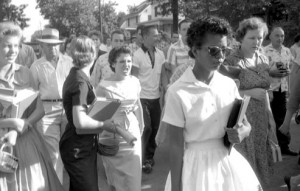This week, I would like you to consider two photographic works taken at the very beginning of the Civil Rights movement in the 1950s. In 1955, Swiss-born photographer Robert Frank traveled across the country taking photographs of people. Unbeknownst to him was the impact his photographs would have in their published form, The Americans (1958/1959). Described as “un-American” or as a “sad poem by a very sick person,” The Americans captured the social undercurrents of life in the 1950s. Frank’s unique style was highly influential to following generations of photographers. His photographs often revealed a social divide between blacks and whites in America, a rift that his critics did not wish acknowledge. Just two years later, a phenomenal photograph was taken on the first day of a desegregated school, which suggests that Frank had indeed felt the true pulse of America. Read (or listen) about these two works: Frank’s The Americans and the photo-journalist Will Counts’ image of Elizabeth Eckford going to high school in Little Rock, AK in 1957. Do you think one type of photography, Frank’s “art” photography vs. Counts’ news photography, is more effective than the other? Or are both powerful visual documents of social inequities in American society of the Fifties?
Read (or listen) to NPR’s report on Robert Frank’s The Americans
Read the story behind Will Counts’ photograph of Elizabeth Eckford
Please post your responses before the end of the semester.
See instructions on how to “post” and “comment” under “Blogging Guidelines” above.






I believe that the news photo shows more emotion were as Frank’s photo is more subtel. However, they both are effective in portraying the same message, considering the uproar Frank’s work went through in the American culture of not showing his work in museums or gallaries.
Both were effective in their own ways and accomplished the goal of exposing the nature of society in its rawest form. I couldn’t decide which was more effective, the reason being that The American captured how those less fortunate than us were dealing with their daily lives and how strive to feed their family and keep a roof over their heads. While Counts’ photos documented how the situation was before equality and how segregation and desegregation affected the way people treated each other.